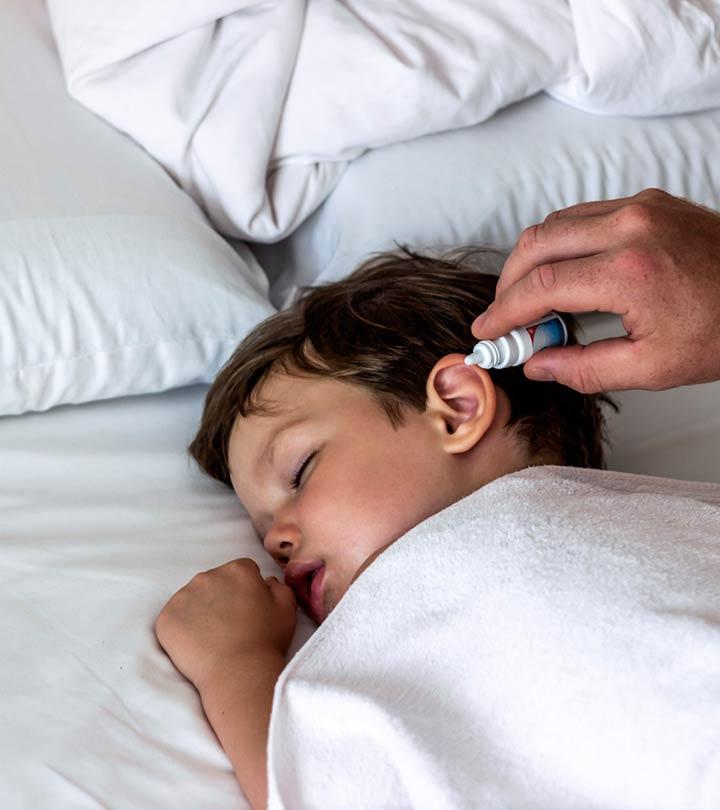Ear drops are medications used to reduce ear infections or to dissolve ear wax. These medications come in an easy carry-on bottle with a dropper or a protruded tip. Ear drops are an effective way of relieving pain or clearing ear blockages. Timely and proper administration of ear drops in children could prevent the spread of ear infections and discomfort that follows.
Although several over-the-counter (OTC) ear drops are available in the market, it is advisable to consult a doctor before their administration. A doctor considers the underlying cause and would prohibit the usage of drops if the eardrum is ruptured (1). This post talks about ear drops for kids and steps for its administration.
Types Of Ear Drops For Children
Ear drops could be of several types based on their purpose and effect. They can be broadly classified into the following types.
1. Earwax removal drops
A buildup of earwax in the ear canals could be uncomfortable. This buildup may lead to bacterial infection, ear pain, ear discharge, itchiness, or hearing loss. It may even cause a foul smell to emanate from the ear canal. Removing the ear wax is the best solution in such cases (2).
Earwax removal drops work by either dissolving the wax or by loosening it. These drops could be oil or water-based and have any of the following active ingredients (3).
- Glycerin: It works by softening the wax, which can later be removed.
- Saline solution: A saline solution softens hard wax for easy removal.
- Baking soda: The alkaline nature of baking soda counteracts the acidic nature of the ear wax to dissolve it.
- Mineral oil: The use of mineral oil softens dried ear wax, which can later be removed easily.
- Acetic acid: It is available in a diluted, water-based form. It softens and dissolves the ear wax.
- Carbamide peroxide: Carbamide peroxide application releases oxygen in the The foam caused by the oxygen loosens and softens the wax (4).
Earwax removal ear drops are often available over the counter. Since ear drops may not suit sensitive skins, it is ideal to consult a physician before using them.
2. Anesthetic ear drops
These drops aim at providing temporary relief from earache due to outer or middle ear infections. A few OTC ear drops may contain harmful ingredients, which may exacerbate ear infections. Hence, it is crucial to consult a pediatrician. The FDA does not recommend the following ingredients and their combinations in ear drops as they could cause adverse reactions (5).
- Benzocaine and antipyrine
- Benzocaine, antipyrine, and zinc acetate
- Benzocaine, chloroxylenol, and hydrocortisone
- Chloroxylenol and pramoxine
- Chloroxylenol, pramoxine, and hydrocortisone
Anesthetic or numbing ear drops may or may not contain antibiotics. Therefore, they are not the primary method of treating ear infections and are used as painkillers. Anesthetic ear drops should only be used after medical advice (6).
3. Ear drops for swimmer’s ears
Otitis externa (swimmer’s ears) is an infection of the outer ear canal often caused by the repeated accumulation of water in the ear canal. The drops contain isopropyl alcohol or glycerin as the active ingredient, aiming to dry the ear. Although these drops primarily aim at drying the trapped water, they may come in combination with antibiotics to treat the infection (7).
Steps To Administer Ear Drops
Administering ear drops to a child is an easy process. Almost all the brands require you to follow the below steps for giving ear drops (1).
- Before giving the ear drops, ensure that you’re giving them the right medication.
- Wash your hands before giving them the drops.
- Shake the medicine bottle gently.
- Never touch the tip of the medicine bottle as this may contaminate the contents.
- Ask your child to lie down with their head on a pillow with their ear facing upwards. They may also use a chair.
- For a child below three years of age, gently pull their ear down, whereas for children above three, pull the ears up and back. This ensures that the ear canal is wide open for the ear drops to penetrate well.
- Gently squeeze the medicine bottle to release the drops into the ear. Count the drops and stop after the prescribed amount is instilled into the ear canal.
- Shake the ear flap and ask your child to tilt their head gently for a few minutes. You must check that the drops have entered the canal and have not flown outside. Do not use cotton swabs to push the drops into the ear.
- Repeat the steps on the other ear, if suggested or needed.
- Replace the cap on the medicine bottle after usage.
Precautions To Take While Using Ear Drops
Here are a few precautions that can be exercised while using ear drops for children.
- Use the drops in the affected ear only and as prescribed by doctors. Always check the labels for the expiration date and the active ingredient list.
- Follow any preliminary requirements as instructed by the doctor on the prescription label. These instructions may include cleaning the outer ear surface, especially in case of outer ear infections.
- Do not insert the tip into the ear as this may contaminate the bottle tip. Hover it over the ear canal opening carefully to administer the drops.
- Always remember to count the drops and follow the instruction of the doctor about the doses.
- You may try warming up the bottle in between the palms to avoid dizziness caused by the slight coldness of some ear medications.
- Never rinse the dropper, and avoid touching its tip.
- Do not use a cracked, chipped, or dirty dropper. Replace the medication with a fresh one if the tip is damaged.
- If it leads to an allergic reaction, such as itching or burning, stop usage and consult the doctor.
- Keep the bottle away from a child’s reach and never let the child self-administer the medicine.
Ear problems, such as ear infections, are common in children, and ear drops are often used in their treatment. They are safe medications, provided you use them as per the doctor’s instructions. If the child shows no improvement for several days, speak to the doctor. Avoid using OTC ear drops since they could contain harmful compounds. The correct use of ear drops and the right dosage are essential to avoid any adverse effects.
References:
MomJunction’s articles are written after analyzing the research works of expert authors and institutions. Our references consist of resources established by authorities in their respective fields. You can learn more about the authenticity of the information we present in our editorial policy.
Recommended Articles
The following two tabs change content below.




































